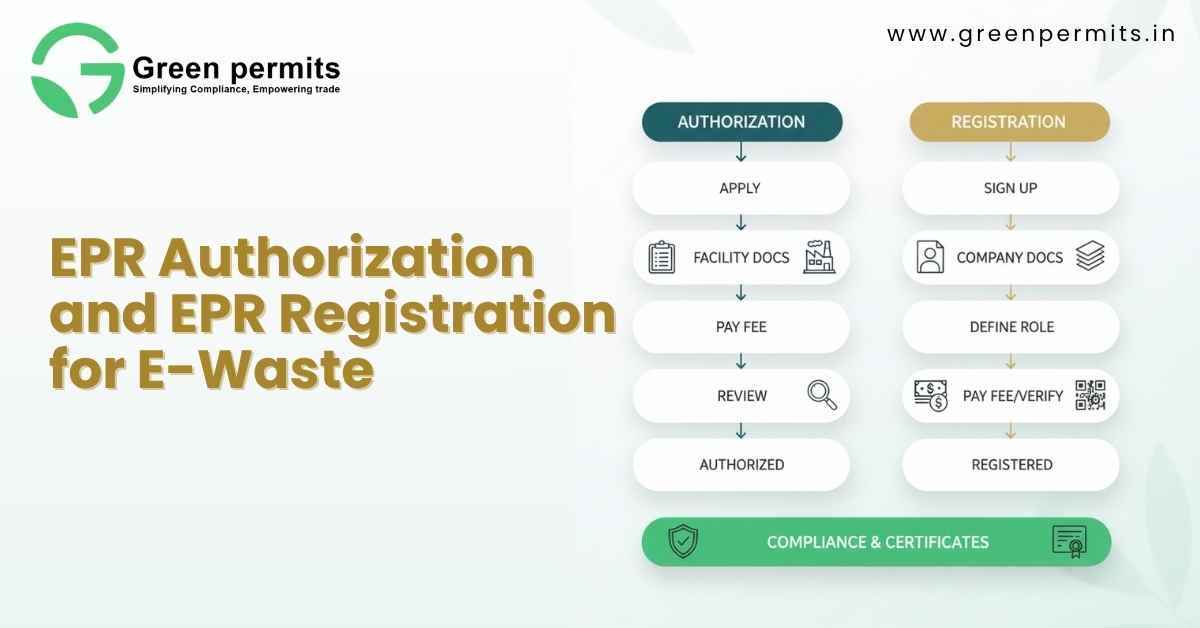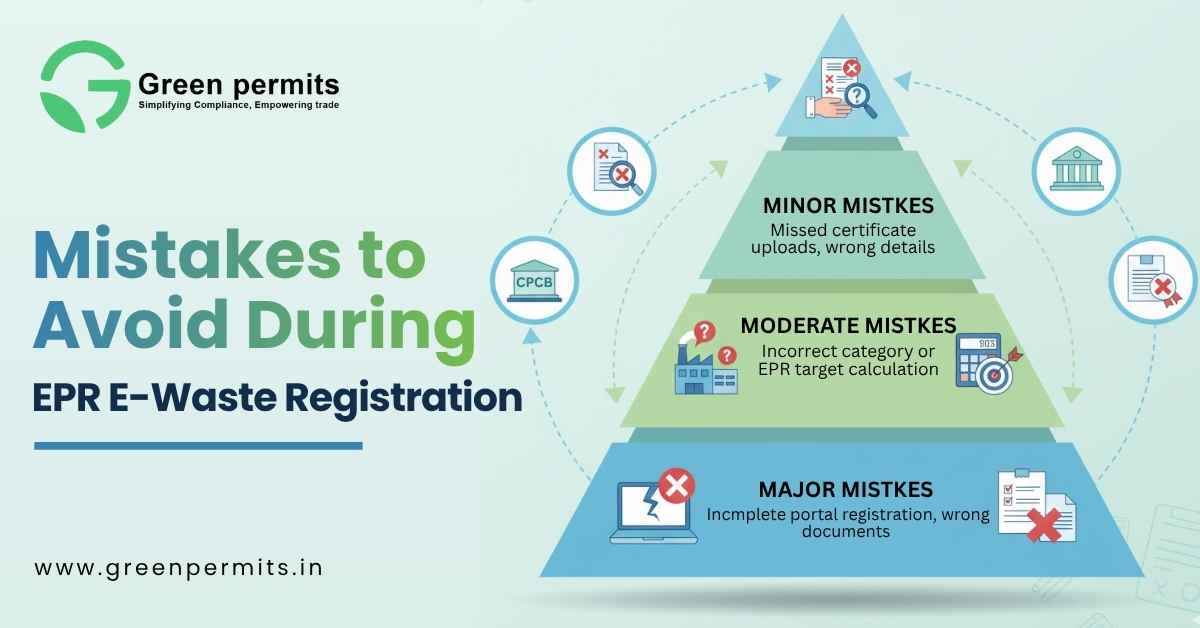When EcoReclaim Recycling Pvt. Ltd., a mid-sized recycler from Pune, began operations in 2023, their plant was ready and buyers were waiting—but orders couldn’t move because the team hadn’t yet completed its CPCB EPR registration. Each week of delay meant idle machines, storage backlogs, and lost contracts.
For hundreds of recyclers like EcoReclaim, registration under the Central Pollution Control Board (CPCB) isn’t a formality—it’s the license to operate. This guide simplifies the entire process under the E-Waste (Management) Rules 2022, explaining how to register, what to prepare, and how to avoid common mistakes that cause rejection or delay.
Understanding the EPR Framework for Recyclers
The E-Waste (Management) Rules 2022 made registration mandatory for every manufacturer, producer, refurbisher, and recycler handling electronic waste in India. Recyclers form the backbone of this framework—recovering valuable metals, plastics, and components from discarded electronics.
Without registration:
- You cannot legally collect or process e-waste.
- You cannot generate or trade EPR certificates, which producers rely on to meet compliance targets.
- Dealing with unregistered entities can lead to penalties and cancellation of agreements.
The EPR portal, launched by CPCB, ensures that only compliant recyclers participate in India’s formal circular-economy system.
Step 1: Access the CPCB EPR Portal
Visit https://eprewastecpcb.in and click on “Recycler Registration.”
The portal is designed for transparent, paperless processing.
You’ll create login credentials by filling out:
- Company name and address
- GST number and authorized person details
- Valid email and mobile number
An OTP verification confirms both email and phone. Make sure you use contact details linked to decision-makers so that CPCB queries reach you quickly.
Step 2: Prepare Basic Company Information
The registration process begins with detailed business identification. Keep the following ready:
- Registered office and plant address with geo-coordinates
- Year of establishment and installed recycling capacity
- CTE (Clearance to Establish) and CTO (Clearance to Operate) from your State Pollution Control Board
- Hazardous Waste Authorization under the 2016 rules
- PAN and GST certificates showing the same location as the plant
- Photos and a geo-tagged video of the operational facility
A mismatch between addresses in these documents is the most common reason for CPCB checklist observations.
Step 3: Declare Your Recycling Capacity and Products
Within the portal form, recyclers must specify:
- Categories of e-waste handled (IT equipment, consumer electronics, lighting devices, etc.)
- Annual capacity in tonnes per year (as approved in your CTO)
- Details of recovered materials — copper, aluminium, iron, plastic granules and precious metals
- List of final products sold to producers for EPR certificate generation
Explain your material-flow process clearly. For instance, state whether dismantling and refining occur at one site or multiple locations. Clarity helps CPCB verify your process efficiently.
Step 4: Upload Supporting Documents and Declarations
All evidence must be uploaded in PDF format.
| Document | Purpose / Remarks |
|---|---|
| CTE & CTO Certificates | Confirm legal operation under state pollution laws |
| Hazardous Waste Authorization | Shows approval to store and process hazardous components |
| PAN & GST Certificates | Must reflect same address as plant location |
| Geo-tagged Photos / Video | Demonstrates operational status and safety arrangements |
| Self-Declaration Letter | Confirms authentic data and adequate fire and occupational safety measures |
Use consistent file names and ensure each document is current. Incomplete uploads are automatically flagged for review.
Step 5: Application Review and Digital Checklist
After submission, CPCB reviews applications within 30 working days.
If any document or data is missing, a digital checklist appears in your dashboard with remarks. You’ll have seven days to make corrections and re-upload files.
An accurate and well-organized submission often clears in a single review cycle, saving weeks of follow-up.
Step 6: Approval and Facility Verification
Once verified, CPCB issues a digital registration certificate valid for five years.
Within three months of approval, officials conduct a virtual or physical inspection to confirm the facility matches submitted details.
If any discrepancies arise—such as inactive video links or non-operational equipment—the registration can be suspended after notice.
Step 7: Fee Structure for Recyclers
| Category / Activity | Fee (INR) | Validity | Additional Notes |
|---|---|---|---|
| New Registration | 15,000 | 5 Years | One-time portal processing charge |
| Renewal of Registration | 7,500 | 5 Years | Submit before expiry to avoid deactivation |
| Profile Amendment | 3,000 | – | Used for adding extra products or capacity |
| Annual Maintenance Charge | 5,000 per year | – | Covers portal upkeep and record management |
Timely renewal ensures uninterrupted access to the EPR certificate trading module and avoids loss of revenue.
Step 8: Post-Registration Responsibilities
After receiving approval, the recycler must:
- Record daily intake and output quantities on the EPR dashboard.
- Generate EPR certificates based on the actual weight of key metals recycled (copper, aluminium, iron, gold).
- Maintain operational safety and pollution-control standards.
- File quarterly and annual returns online before the due dates.
CPCB uses these returns to track national recycling performance and assign EPR credits to producers.
Compliance Risks and Penalties
Failure to comply with the rules can lead to serious consequences:
- Submitting false data or inactive geo-videos can result in suspension of registration.
- Non-filing of annual returns may lead to deactivation of the portal account.
- Trading EPR certificates without actual recycling is considered fraud and punishable with fines.
Illustration: In 2024, a Delhi-based recycler had its registration cancelled after it was found that its facility was non-operational during inspection. The business incurred a ₹2 lakh penalty and was barred from re-application for six months.
Why Timely Registration Matters
For recyclers, registration is not just a legal step—it’s a competitive advantage.
- It builds trust with OEMs and importers who require EPR certified partners.
- It permits lawful participation in EPR credit trading and contract bidding.
- Early registrants avoid processing backlogs and state approvals delays.
- Compliance opens doors to corporate tie-ups and ESG funding opportunities.
Many consultants observe that businesses that apply within the first quarter of operations reduce their approval time by over 40%.
Conclusion
Becoming a registered recycler on the CPCB EPR portal is a cornerstone of modern waste management in India. It assures buyers and regulators that your unit is legally compliant, environmentally responsible, and ready to support the nation’s sustainability goals.
With complete documents and guidance from experienced consultants, the entire process can be completed smoothly in about a month. For recyclers like EcoReclaim, timely registration translates directly into operational freedom and market credibility.
CTA – Talk to Green Permits
📞 +91 78350 06182 | 📧 wecare@greenpermits.in
Book a Consultation with Green Permits to streamline your CPCB registration and get end-to-end support for EPR compliance.
Book a Technical Call with Expert
FAQs
Five years from the date of issue.
CTE, CTO, Hazardous Waste Authorization, PAN, GST, geo-video, and a self-declaration letter.
Usually within 30 working days if the submission is complete.
Yes, but each facility must have its own CTE and CTO and be declared on the portal.
The account is deactivated and you must apply afresh, losing existing EPR credits and market access.



